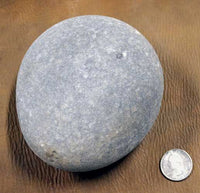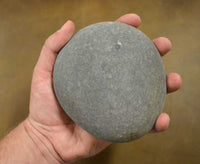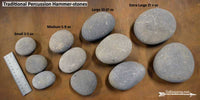Extra- Large Hammerstone
Semi-round extra-large natural hammer stone weighing 21 oz or more; Primarily used for rough reduction of large to very large material and light spalling.
Our current batch of hammerstones are naturally smoothed and rounded by water currents and tumbling over hundreds of years. These are primarily composed of basalt, and are a bit softer than quartzite hammerstones. Ideal for early bi-facing on high quality spalls of heated cherts or volcanic material.
Hard hammerstones are particularly unforgiving for delicate percussion use, and will destroy a fragile blade easily with one misplaced strike. All of our hammerstones have been hand sorted for size, shape, and consistency of material to avoid defects that would cause them to break prematurely, however any violent strikes into hard material or badly prepared platform will speed up any tool failure.
________________________________________________
Traditional tools are also known by flint knappers as 'abo' tools (derived from the word aboriginal). These terms refer to tools that are made of natural materials and are similar in function to the implements used by our stone tool making predecessors throughout the course of human technological development. Examples of other abo tools include hammerstones of various densities and shapes, antler tine flakers, rib bone flakers, lashed flakers, wood billets, sandstone edge modifiers, and billets created from the base or 'crown' section of antler.
Flint knapping with traditional tools is immensely rewarding, though challenging to use and not the easiest to learn with. There remains something to be said for recreating the process that is largely accepted as one of the most important technological advances in human history with nothing more than items found on the forest floor.










